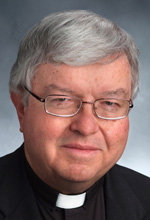Q. I know I speak for many, many concerned grandparents who put their children through Catholic school in the 1970s, 1980s and 1990s, foolishly trusting that the schools were still truly Catholic, as they were when we attended them.
I am not naive; I remember the late 1960s when we lost the wonderful, devoted nuns who taught me and my friends. But now we agonize over our precious grandchildren, who are not being baptized because their parents were never really taught the faith. (I feel terrible guilt now that I didn’t go over their religion texts thoroughly.)
My question is this. I desperately want my precious 8-month-old grandson to be baptized. If I ask a priest to do so, I’ll probably be turned down. Can I baptize him myself, or would that baptism be valid only if there were danger of imminent death? (God forbid.) (San Francisco, Calif.)
A. Like you, I regret that the days are long gone when we had large numbers of women religious staffing our parish schools. I, though, am still a strong believer in the value of Catholic education. From direct experience, I am familiar with Catholic schools today, which are staffed by faith-filled laypeople, using texts that are theologically solid and turning out students who are academically proficient and spiritually sound.
[hotblock]
As for your grandson, I, too, am bothered that he is not yet baptized, but you should not baptize him yourself. First of all, for a baptism to be done licitly (i.e., lawfully) in a non-emergency situation, it is required by the Code of Canon Law, in No. 868, that at least one parent (or the person responsible for raising the child) must consent and that there be a well-founded hope that the child will be raised in the Catholic faith.
Technically, if you were to perform the baptism yourself it would be “valid” — i.e., it really happened, provided you had the right intention. But it would violate church law. Even if it were lawful for you to perform the baptism, I would advise against it.
If the child’s parents were to find out, they could be legitimately resentful, which would drive them further from the faith and make it less likely that your grandson would ever be raised a Catholic.
My guess is that you are worried that, should the child die without being baptized, he could never enter heaven. You should lay that worry to rest. The church has never defined limbo as dogma, and the current Catechism of the Catholic Church suggests in No. 1261 that we can confidently entrust an unbaptized infant to the mercy of the Lord, knowing that God wants all people to be saved and that Jesus said, “Let the children come to me.”
Surely, though, the ideal is that the child be baptized soon and raised a Catholic, so you should look for an appropriate opportunity (perhaps you’ve done this already) to explain to the parents how much your faith means to you, how it has helped to guide your life and how deeply you desire that your grandson might have that same gift.
Don’t discount, either, the importance of prayer. For decades, Monica — with daily prayers and many tears — pleaded with God to guide her son Augustine to the Catholic faith, and he became, in the end, one of our greatest saints.
Q. I would like to know the church’s official stance on the peace sign. My daughter attends an all-girls Catholic school. Recently I saw a picture on the school’s website where students and the nuns who teach them had lined up to form the peace sign.
That sign has clearly had a troubling past. Even if one were to discount the allegations that it is satanic, why would we promote a symbol designed by a man who was an avowed atheist and communist?
Why not instead promote peace through Catholic doctrine and the symbol of the cross? (Titusville, N.J.)
A. There is no “official” church stance on the peace sign. It was designed in 1958 by a British commercial artist named Gerald Holtom, who had been commissioned by the Campaign for Nuclear Disarmament (CND).
Holtom combined the semaphore flag signals for the letters “N” and “D,” within a circle symbolizing the earth. (“N” is two flags held in an upside-down V and “D” is one flag pointed straight up and another pointed straight down.)
The CND was headed at the time by the philosopher Bertrand Russell.
Russell rejected Communism, which he said was “undemocratic,” but he was an admitted atheist and felt that religion served to impede the development of knowledge. In 1970 the conservative John Birch Society published pamphlets comparing the peace sign to a satanic symbol of an upside-down, “broken” cross.
***
Questions may be sent to Father Kenneth Doyle at askfatherdoyle@gmail.com and 40 Hopewell St., Albany, N.Y. 12208.
PREVIOUS: Pope Francis: Discern good from bad in ‘flea market’ of desires
NEXT: Authority in preaching comes from loving like Jesus did, pope says




Share this story